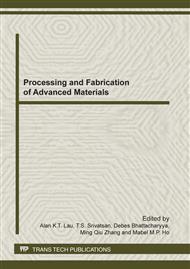p.81
p.86
p.90
p.94
p.98
p.102
p.106
p.110
p.114
Emulsion Electrospinning of Nanofibrous Delivery Vehicles for the Controlled Release of Biomolecules and the In Vitro Release Behaviour of Biomolecules
Abstract:
Electrospinning is a popular technique for constructing nanofibrous tissue engineering scaffolds. Electrospinning is also amenable to the incorporation of drugs or biomolecules in fibers, which can provide local and sustained delivery of biological signals, such as growth factors, for the seeded cells. Drugs can normally be dissolved in polymer solutions for electrospinning, forming nanofibrous drug delivery systems. However, simply blending biomolecules in polymer solutions can result in denaturation of biomolecules and large initial burst release. Therefore, emulsion electrospinning, which can provide protection for biomolecules during electrospinning, is of great interest. In this investigation, biomolecule-containing scaffolds were emulsion electrospun using bovine serum albumin (BSA) as the model protein. Two polymers, poly (lactic-co-glycolic acid) and poly (D,L-lactic acid), were used due to their different degradation characteristics. Nanofibers with core-shell structures were electrospun from water-in-oil emulsions formulated by polymer solution, BSA-containing deionized water and a surfactant. By changing the polymer concentration and water phase volume, the fiber diameter and core-shell structure were varied. With different polymers and different fiber structures, the in vitro BSA release behaviours from fibrous scaffolds were different.
Info:
Periodical:
Pages:
98-101
Citation:
Online since:
November 2011
Authors:
Price:
Сopyright:
© 2012 Trans Tech Publications Ltd. All Rights Reserved
Share:
Citation:


